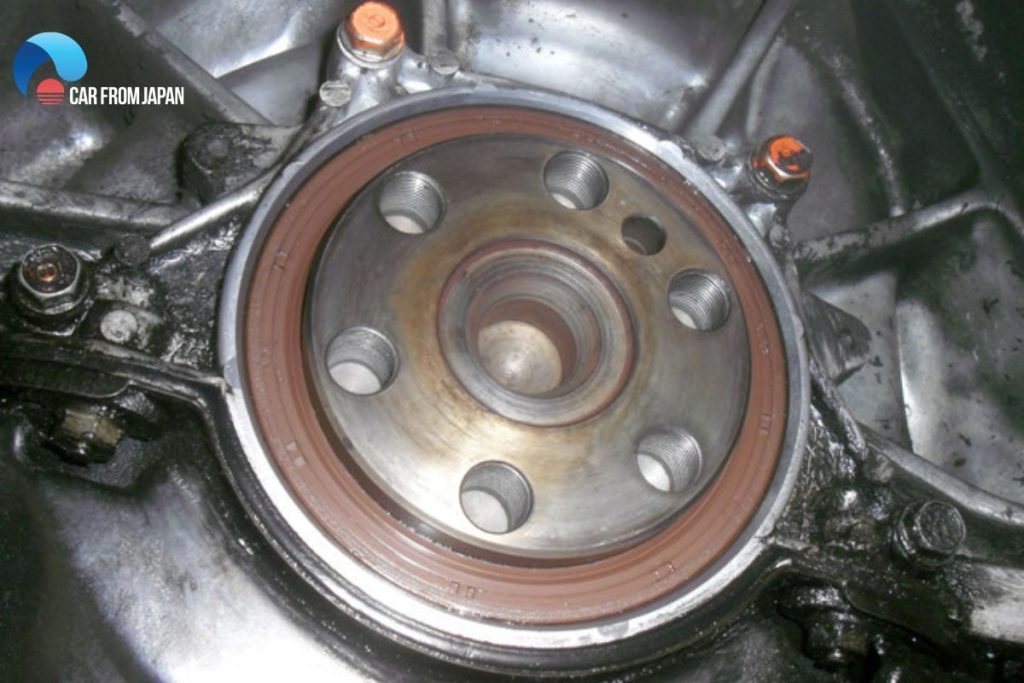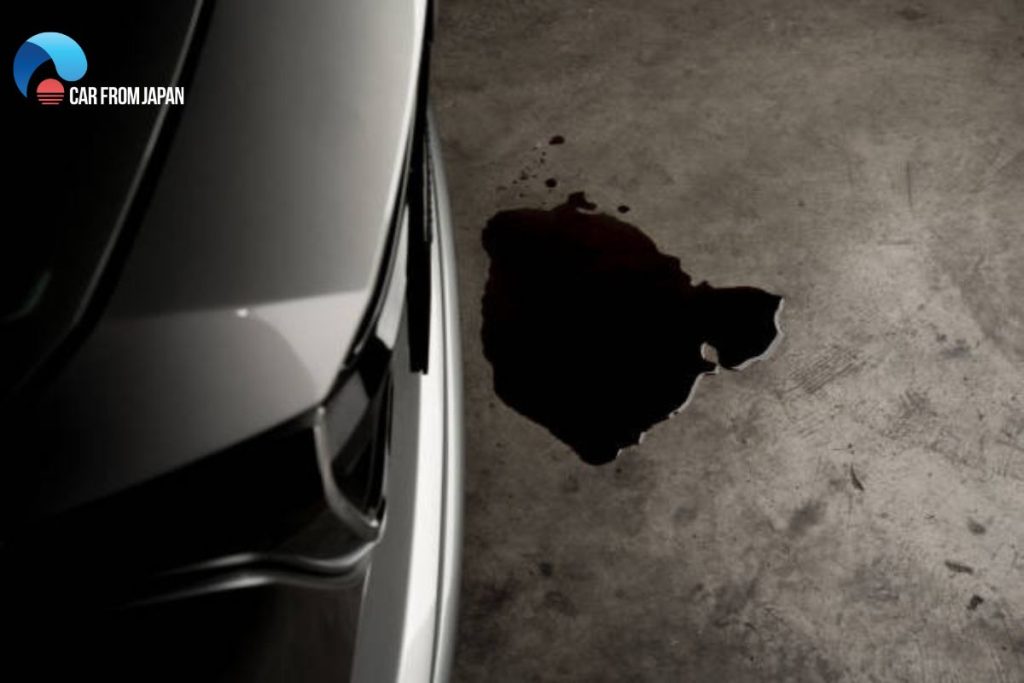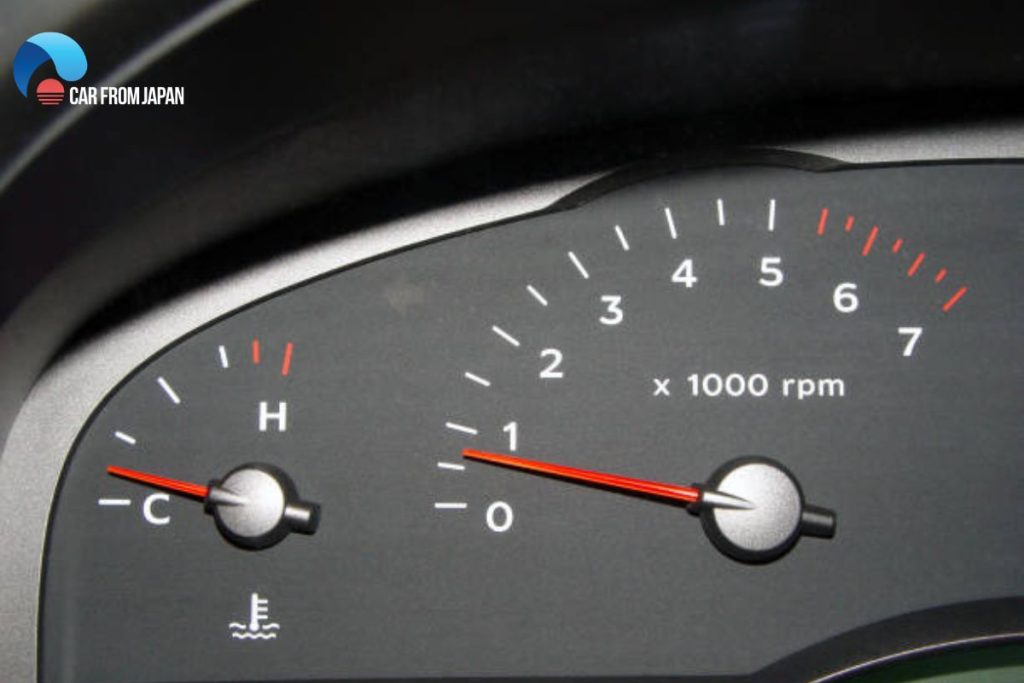Do you have oil spots in your driveway or a leaky engine block when you look under your vehicle? Sorry, super bad news: you might have a rear main seal leak. This particular seal is tucked away deep in your engine, making it a bit tricky to pinpoint. Recognizing the specific symptoms of a rear main seal leak is the first step. Then, knowing how to diagnose it from other possible oil leaks can save you a lot of guesswork and help you address the problem correctly.
Contents
What Does A Rear Main Seal Do?
The rear main seal is designed to prevent oil leaks between the block and crankshaft. As it is buried deep in your vehicle’s engine compartment and is hard to reach, manufacturers originally intended rear seals to last the life of a vehicle.
So that no replacement is needed, unlike many other engine components under the hood that require replacement every few years.
The rear main seal is situated just outside of your rear main bearing, which supports the crankshaft for your motor in your engine.
These bearings carry the majority of the load in your engine and play a crucial role in turning the axial motion of your piston into the rotary motion of the crankshaft.
The rear main seal allows the crankshaft to exit the engine case so it can bolt to the flywheel or flex plate and transfer its energy into the transmission.

Is A Rear Main Seal Leak Serious?
A rear main seal leak is among the worst things that can happen to any vehicle because the rear main seal is very hard to reach, and it requires much of your engine to be disassembled. On most modern engines, the seal’s failure is due to a condition inside the engine or a component connected to the back of the engine, and is most common in older cars:
Fast leak and permanent engine damage
Driving with a rear main seal leak is dangerous due to the high possibility of a very fast leak.
A fast leak will lower your engine oil level to dangerous levels very quickly, which can lead to permanent engine damage.
The possibility of a fast leak is very likely, as the rear main seal is in a place that gets a lot of oil thrown at it and has the added wear of the crankshaft spinning inside.
If the seal tears or cracks even only slightly, the crankshaft rotation can cause the seal to get torn up very quickly causing a fast leak.
A quick side note is that when a vehicle is parked at an angle, an oil leak is bound to escalate much faster.
Therefore, if your driveway is built on an incline, park your car on the level street in front of your house until the problem is fixed.
On vehicles with manual transmission, the clutch disc can become soaked with oil if you let a leak persist for too long.
High risk of leak
Some seals and gaskets in your engine never cause severe leaks because of the design or because they are not subjected to high oil pressure in the engine. In contrast, the rear main seal is an engine component that is highly likely to develop a leak.
No matter how often you change your oil, eventually the spinning metal crankshaft will wear down the seal enough to cause a leak.
Expensive repair and replacement
As mentioned before, rear main seal inspection and replacement require much of your engine to be disassembled. Therefore, labor costs would be very expensive, and of course, if you are not a professional handyman, this would be a very complicated project.
The problem is the location of the rear main seal. It is at the back of the engine and seals the crankshaft as it exits the engine.
Your vehicle’s flywheel or flexplate is then bolted onto the crankshaft flange, sandwiching your rear main seal between your engine and transmission.
To replace the seal, either the engine or the transmission will have to be removed. Once one of those is removed, the oil pan also has to come out, so this maintenance job is extremely labor-intensive.
Rear Main Seal Leak Symptoms
The issue can be hard to identify because the parts in question are relatively unknown to most car owners.
The hard-to-reach location of the rear main seal goes to show how this part of the vehicle was never really intended to be replaced during the span of the car’s ownership.

How to tell if rear main seal is leaking? The main symptom of a rear main seal leak is when your car starts leaving black stains on your driveway or parking lot.
Another sign is aggressive oil loss: you find yourself needing to top off your oil more frequently, despite the same routes and driving conditions.
At the early stage of a leak, oil loss might not be rapid enough that you would find black stains where the vehicle has parked.
While you might see an oil stain in your driveway overnight, the leak might not be fast enough to leave its mark in the supermarket parking lot on your grocery trip. Therefore, you might need to run tests to determine whether you’re losing oil or not.
Rear Main Seal Leak Causes
There are many rear main seal leak causes. Any of the following conditions can cause your rear main seal to leak because they can deform or deteriorate the seal.
Worn main bearings
If your vehicle has worn main bearings, the crankshaft will move excessively inside the bearings which will stretch and move the rear main seal while the engine is running. This will allow oil to leak past the seal.
It is difficult to tell if your engine has worn main bearings without removing a lot of components.
If this is the cause, you’re most likely in for a full engine rebuild which would include removing the motor and replacing many other components in addition to the rear main seal itself.
Clogged or blocked PCV system
Most rear main seals have a lip that rides on the shaft. The pressure inside the crankcase will push the lip onto the shaft. Too much pressure will eventually cause the lip to balloon and allow oil to pass.
Then when will there be too much pressure? If the Positive Crankcase Ventilation (PCV) system is blocked, it will increase the pressures inside the crankshaft and push out the seal.
Otherwise, if the engine is supercharged or turbocharged, excessive blowby due to worn or damaged piston rings can cause increased crankcase pressure that can also damage the rear main seal, causing a leak.
Engine oil condition
Another common cause could be due to a low oil level or using the wrong type of oil. Most oils have chemicals in their additive packages that will condition the seals in the engine. If the oil is not changed regularly, it will cause the seal to deteriorate.
The seal conditions are depleted over time along with buffers in the oil. The lip that rides on the crankshaft will become stiff and will not be able to seal itself against the crankshaft.
Crankshaft condition
The rear main seals have a lip that directly rides on the crankshaft. Therefore, the condition of the surfaces that the rear main seal rides on is critical.
Any imperfections or wear on the crankshaft can cause a leak. There are sleeve kits that can be installed on the crankshaft to restore the surface.
Misalignment issues
If there are any alignment problems with the bell housing or input shaft of the transmission, they can cause stress on the rear main seal.
Make sure you check the input shaft on a manual transmission. On vehicles with automatic transmissions, check the flex plate for lateral runout or damage.
Seal coating
In rarer cases, some rear main seals need to be installed dry. These seals have a polytetrafluoroethylene (PTFE) coating on the lip seal that needs to be dry and seat to a dry surface on the crankshaft.
The seal will transfer a layer of PTFE to the crankshaft surfaces that the lip will ride on.
The transfer layer prevents wear while sealing better than a silicone or Viton material. If the seal is installed with a coating of oil, it will start to leak in a few miles.
Rear Main Seal Leak: Troubleshooting
Since the rear main seal is in a position that you won’t be able to slide under your car and inspect directly, your best course of action upon finding stains in your garage is to go through a process of elimination.
If you seem to be losing oil, but you don’t have a noticeable drip when the car is parked, you may be in the early stages of a leak.
Idle the engine

The first step and a simple way to test if your car is leaking oil is to idle the engine for 15 minutes to see whether any oil appears on the surface underneath.
Since the car’s movement and other car parts can tend to hide oil leak symptoms, most evidence of leaks is overlooked.
For example, oil could be getting splashed along chassis components as you drive at highway speeds.
By running the car at a standstill, you get a better indicator of how oil is consumed during commutes along roads and highways.
Using dye
In the case that you’re finding oil stains or experiencing excessive oil loss, it is not necessarily your rear main seal that is leaking.
On most engines, oil leaks can occur above and below the rear main seal. It could be a leaking oil pressure sensor, oil pan gasket or galley plug near the seal that causes oil to come from the bell housing. Adding dye to the oil can help reveal where the oil is coming from.
Check the transmission and oil pan
If you have determined that your car is leaking oil, check the transmission and oil pan. If oil appears on the front of the transmission and at the back of the oil pan, it could be due to a rear main seal leak, but there are still other possibilities.
Therefore, it’s important to check further up in the engine compartment for drips. After all, you might discover a critical yet different problem with your vehicle that would ultimately be easier and cheaper to fix.
Check valve cover gasket and valley pan
Other places to inspect for leaks are the valve cover gasket and valley pan. The cover gasket and valley pan are easier and less expensive to replace than the rear main seal.
You’ll need to get under the vehicle with a flashlight to check these parts. For added protection, you’ll probably want to put on grubbies, goggles and protective gear around your head.
Check out this video from Wrenching With Kenny to learn more about some helpful tips to avoid rear main seal leak issue!
Rear Main Seal Replacement Cost
Typically, a rear main seal replacement cost can start from around $400 and go all the way up to over $1500, sometimes even more. The main reason for this wide range and often high price isn’t the seal itself – the part is usually quite inexpensive, often costing between $20 to $50. The real expense lies in the labor.
To access the rear main seal, mechanics usually have to remove the transmission, and sometimes even parts of the exhaust system or driveshaft, depending on the vehicle’s design (front-wheel drive, rear-wheel drive, or all-wheel drive). This is a time-consuming process, often taking anywhere from 5 to 10 hours, or more in complex cases.
Final Thoughts
Ultimately, recognizing the symptoms of a failing rear main seal—such as oil on the clutch if you have a manual, or those tell-tale drips that form between the engine and transmission—is the first step. Following up with a careful diagnosis to confirm the source of the leak is essential before undertaking what can be a significant repair, ensuring your engine remains well-lubricated and protected.



